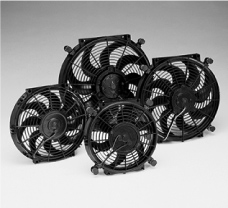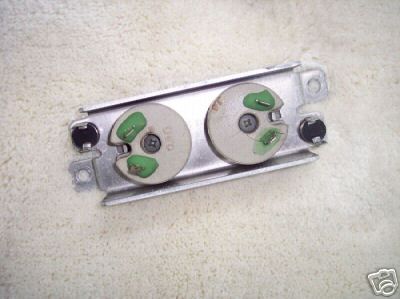| Radiator fans: The bearings on the fans have been known to fail. I will replace
the fans with either new ones from Summit, or perhaps I can pull a pair
from a wrecked BMW/MB or something with a big engine. I would like
to find fans with curved blades, as they should be quieter and draw less
power than straight blade fans with the same CFM throughput.
Some views of the original fans: |
|
|
| I found two 12" electric fans for $42 each at
Old Air Products.
After some more research I discovered they are
Hayden fans.
an image from the Hayden website catalogue:

Images as installed on the condensor. Click the thumbnail to
select the image. |
|
|
| |
| Nice, aggressive s-curves on the blades. It's
evident some R&D money was spent on these fan designs. Better
than a straight piece of plastic at an angle to the incoming air. |
| |
| Radiator Fan Wiring Harness: The harness on the car was a complete piece of shit. Relays were
switching relays, there were those clamp-on splicers ( always a bad sign),
a wire from the ignition had its insulation peeled off, and a relay
controller was actuated from it. Just a complete fucking mess.
I tore everything out. The original factory design ran both fans
if the rad was hot, but just one fan if the a/c circuit was actuated.
Bullshit. A later OEM design rigged the fans so that they would
operate at two speeds.
|
| Here's Citroen's complicated
approach to a two-speed fan arrangement with two fans. Click on
the thumbnail of the wiring diagram to see a larger version. |
|
|
| The Low Speed The coil for the
relay at the top gets hot from the ignition key
The air thermostat (11) measures temperature of the air behind the
radiator, at a certain point, it closes the circuit, energising the
coil in the relay at the top.
This relay allows power to flow to one fan (7)
the ground wire for fan (7) goes back to terminal four at relay
(13) on the left wheelwell. This relay is a Single Pole Double Throw.
Unenergised, it allows terminal three to source its power from
terminal four
Terminal three is connected to the second fan (8). The second fan
gets "used" power of the first fan. Since the two fans are connected
in series, each gets 6 volts of power, and runs at "half-speed"
|
The High Speed The
relay coil at the top gets power from the ignition key, it is
activated by radiator air temperature switch (11). This is the same as
in low-speed operation.
Thermostat (10) measures the water temperature in the radiator.
When it activates:
Relay (13) coil energises, so that terminal three gets power from
terminal "S". Terminal three supplies power to fan (8) This power is
straight 12V from the battery.
Relay (12) coil energises; this connects the ground wire for fan
(7) directly to ground. As this ground wire has no other resistance in
its circuit, the has a full voltage drop of 12V. Both fans receive 12V
power from the battery, both fans are directly connected to ground,
with no intermediary drops. Fans are connected in parallel.
|
| Here's an alternate approach
to two-speed fan wiring. This is usually the case with one fan.
This design was used by SAAB, Ford, VAG, and Citroen when the CX was
equipped with just one fan. |
|
 |
| It's a much simpler
arrangement. There are two thermostats - (10) and (11).
Thermostat (10) is for low speed fan operation. When (10) is hot
enough, it energises relay coil (1) which sends power to the fan (8)
through the resistor (9). The resistor eats up some of the
power, so the fan turns at a lower speed. Thermostat (11)
triggers at the higher temperature. It activates relay (12)
which is connected directly to the fan. The fan receives full
power, and turns at full speed. |
| Here's a typical resistor.
It's obviously meant to handle a lot of power. |
 |
|
Honda does not use speeds - just on & off.
Then I did some research into the fans themselves. Turns out
that each of my 12" fans draws only 8.8 amps each. So, even with
both running without any resistance the consumption would be 17,6
amps. Each fan is rated to push 800cfm standing alone, 675cfm in
front of a radiator.
Since the power draw of the new fans is relatively low, I'm going
to wire a very simple circuit. One relay will be triggered by
either the radiator thermostat or the A/C compressor circuit. It
will provide power to both fans in parallel. No other relays, no
other resistors. Like Honda. |